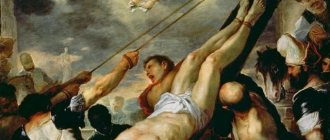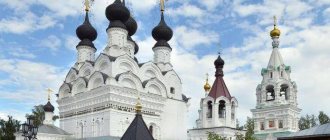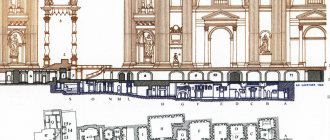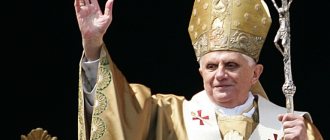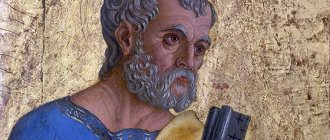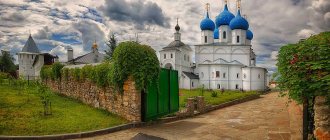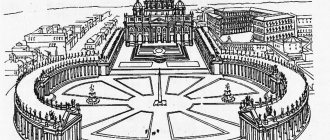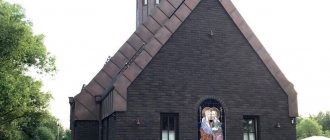The history of the Necropolis
The appearance of a necropolis or burial ground, in ancient Rome and a later period, is associated with the requirement of city authorities, ordering burials to be carried out only outside the city walls.
Such requirements were dictated by the danger of the spread of plague, which appeared from time to time in different areas of Italy.
It was originally a pagan burial place, more than two thousand years .
The reason for the special attention to this place was the presence of the tomb of St. Peter, who, after his martyrdom in 64 AD, was buried in this place.
Despite laws protecting the Necropolis, the first Christian emperor, Constantine 1 the Great (306-337), planned to build a basilica on the final resting place of St. Peter.
He ordered excavations in the area, ordering the preservation of the tomb of St. Peter. The rest of the Necropolis was buried in soil and debris during construction and largely forgotten.
The Vatican Necropolis should not be confused with the Vatican Grottoes, the latter of which resulted from the construction of St. Peter's Church and are located on the ground floor of the old Constantinian Basilica.
Sign Wall
But what mysterious place needed to be surrounded by a wall more than two meters high? The fence was covered with religious writings, for which archaeologists nicknamed it the “wall of signs.” The researchers were able to build the following sequence of events:
- In the year 67, Saint Peter was executed by order of Emperor Nero;
- About 15 years later, Christians bought the land on which the apostle’s grave was located and built a stone wall around it;
- A century later, another fence was built around the burial site.
It should be noted that the soil on which St. Peter's Cathedral was built is of poor quality - it is damp and swampy. For this reason, the massive building had to be erected on stilts, extending several meters into the ground. Archaeologists studied the “fenced place” quite carefully, but the remains of the apostle were never found. However, for most believers this circumstance is not of particular importance.
There is a version that the relics of St. Peter were secretly transported to the San Sebastian caves (Spain) during the persecution of Christians that took place in 258. According to this hypothesis, later, when Emperor Constantine was in power, the relics of the apostle were returned to the territory of the Vatican and safely hidden in one of the many hiding places.
Excavations and searches for the tomb of St. Peter
The first excavations of the Necropolis began on the initiative of Pope Pius XII in the 1940s, and took more than 8 years.
The goal of the search was the tomb of St. Peter, it was believed that it was located directly under the cathedral of the same name.
St. Peter's Basilica in Rome is located on a huge piece of land that the ancient Romans called the Circus of Nero , Nero used his private circus for both personal and public entertainment, such as the murder of Christians, one of whom was the Apostle Peter.
Drawing of the Circus of Nero (Pietro Santi Bartoli, 1699).
There are more than 300,000 people in the area.
After eight years of excavation, analysis and research, XII 's Christmas message of December 23, 1950, informed Mora of the sensation that Peter's tomb had been found: . ”
Another Pope, John Paul VI, confirmed this discovery 18 years later, on June 26, 1968: “We believe that we can make this joyful announcement...we are right in believing that few but sacred mortal remains have been found, the remains of the Prince of the Apostles, Simon, son of Jonah, a fisherman, whom Christ named Peter .
Later, in 2003, during the construction of a parking lot, a large part of the Necropolis was discovered. The tombs under the Vatican are located in 22 mausoleums and lead directly to the famous Sector P.
It is believed that the Apostle Peter is buried here in the tomb of St. Peter.
Below the papal altar of confession in St. Peter's Basilica there is a rough brick tomb (below).
One graffiti on the back of this original tomb bears the ancient inscription: Peter...en..., “Peter is here.”
The entrance to the tomb is under the altar.
This place is underground, but is located directly under the altar of the world famous St. Peter's Basilica.
Three years later, in 2005, Vatican archaeologists announced that they had identified the tomb of the Apostle Paul .
In June 2009, Pope Benedict XVI , aka Joseph Aloysius Ratzinger, announced that carbon dating of bone fragments found in a marble sarcophagus dated back to the 1st century AD.
Plan of the Vatican Necropolis.
What could be a more important place in all of Vatican City than the supposed final resting place of St. Peter? Not as famous as the museums, the Basilica or the Sistine Chapel, a tour of the Vatican Necropolis is worth the money.
This is an exclusive experience, entry only by special permission .
In addition, the conditions inside the Necropolis are not suitable for everyone. For example, it is a bit claustrophobic, so this excursion is not suitable for everyone.
The search for St. Peter's grave continues!
joke
Entrance fees to the Vatican Necropolis
Special visits to the necropolis under the basilica, where the tomb of St. Peter is located, are only possible with special permission issued from time to time by the “Factory of San Pietro” . Visits are organized in accordance with the schedule established by the Excavation Department.
- In order to preserve this exceptional historical and archaeological site, and due to the limited space around the revered tomb of the Apostle Peter, entry is limited to approximately 250 visitors per day.
- Groups consist of approximately 12 people and vary by language.
- Only those 15 years of age or older are admitted - no exceptions will be made .
- Each group is accompanied by a guide. The guided tour lasts about one and a half hours.
Environmental conditions underground will be different, with possible increases in temperature and humidity.
Those who suffer from specific and severe physical problems that may be caused by these conditions, including claustrophobia, should not visit.
The Scavi website promises to accept all requests, provided there is sufficient space in the requested time slot. See here on the official website for more details on how to apply.
Tickets cost €13 and include a full guided tour! There are no discounts.
Recommendations and useful tips for visiting the Vatican Necropolis
Top tip! Tickets are scarce and are sometimes booked months in advance. If you were unable to purchase a permit with a ticket, still come and ask , there are refused tickets. You might get lucky!
Important information about the Vatican Necropolis:
- Please note these rules - this is a sacred place and should be treated as such.
- Appropriate clothing – no skirts, shorts or bare shoulders
- Important for families - no one under 15 is allowed!
- Backpacks are not allowed
- Not suitable for those who suffer from claustrophobia
- Not suitable for those who suffer from problems caused by humid atmosphere
Opening hours of the Vatican Necropolis
Open Monday to Friday from 9am to 5pm. Saturdays until 6 pm
How to get to the Vatican Necropolis?
The Vatican can be reached by many different modes of transport.
The entrance to the Vatican necropolis is located in St. Peter's Square, directly below the basilica.
By Metro, take line A to Ottaviano C. Pietro. Walk to the Vatican in just a few minutes
By bus, lines 64 and 62 stop directly at the Vatican.
By train San Pietro train station is about 10 minutes' walk from the Vatican.
Completion and some interesting things
PS If you are interested in a tour of the Vatican Necropolis, then you better start it quickly so as not to miss your chance!
Are all popes buried in the Vatican? Most of them, yes. But there are also papal tombs in the main churches of Rome, as well as in other churches throughout Italy.
What is the difference between a cemetery and a necropolis? Cemeteries are places where the dead are buried, while a necropolis is a kind of large cemetery, but usually found in places steeped in history or in ancient cities.
Holy Apostles Peter and Paul. Paintings
Famous painters such as El Greco (1541–1614), V.L. Borovikovsky (1757–1825), N.N. Ge (1831–1894) and others depicted the apostles Peter and Paul in their works.
Apostles Peter and Paul, El Greco. Between 1587-1592
Holy Apostles Paul and John. Borovikovsky Vladimir Lukich. 1770s. State Russian Museum, St. Petersburg
Apostle Peter. Ge Nikolai Nikolaevich. 1863 State Tretyakov Gallery, Moscow
Peter Mogila
[1] [2] [3]
There is something mysterious and ambiguous in the image of Peter Mogila. It is difficult to understand whether he was a sincere zealot of Orthodoxy or rather a skillful compromiser... Meanwhile, his historical influence was decisive. And justifiably, his name denotes an entire era in the history of the Western Russian church and culture...
Mogila was perhaps the most powerful and powerful of the Western Russian church leaders of the 17th century. He had genuine sovereign pathos, the ability and desire to rule and win. The son of a Moldavian ruler, “voivode of the Moldavian lands,” he, even with the rank of Metropolitan of Kyiv, turned out to be more of a ruler, a ruler rather than a shepherd...
We don’t know exactly where Mogila studied. Most likely, at the Zamoyska Academy. In any case, he was brought up completely in the Western, i.e., in the Polish spirit. M. b., he also visited Holland for a short time. He was a convinced Westerner, a Westerner in tastes and habits. After the death of his father, the guardians of Peter Mogila were the famous chancellor St. Zholkiewski, and then Hetman Khodkevich. Graves generally had strong and family ties in Polish aristocratic society. The sympathy and assistance of the Polish magnates subsequently helped Mogila in his endeavors...
In his very, very young years, Mogila turns out to be the Pechersk archimandrite - apparently, this is precisely why he entered the Lavra in the first place; His candidacy for archimandrite was suggested by the Polish government. And immediately Mogila began to act in his own way. This was reflected most clearly and sharply in the structure of the Lavra School. According to Mogila's plan, it was supposed to be a Latin-Polish school. And Mogila created it not only next to, but also in contrast to the already existing Fraternal and Slavic-Greek schools. That’s why they were so alarmed in Kyiv. “There was great indignation from the uneducated priests and Cossacks: they started a Latin and Polish school, which had not existed before, and they were saved. They wanted to beat Peter Mogila himself and the teachers to death, as soon as they were persuaded.” So says a contemporary (Sylvester Kossov). From this clash and dispute, Mogila emerged victorious. The brothers had to recognize him as “the elder brother, guardian and founder of that holy brotherhood, monastery and schools,” and transfer the fraternal school to his jurisdiction. The fraternal school dissolved into the newly established, new Latin-Polish “collegium”, which was soon moved from the Lavra to the fraternal monastery...
The program of this new school was taken from the Jesuit schools. And for teaching, Latin students were attracted and called to Kyiv - Isaiah Trofimovich Kozlovsky, the first rector of Kiev schools, and Sylvester Kossov, the first prefect, both studied, apparently, at the Lublin Jesuit College, and then at the Zamoyska Academy (m. ., and in Vienna, at the Caesars Academy). At the same time, a “collegium” was established in Vinnitsa (somewhat later it was moved to the Goshchansky or Goysky monastery in Volyn). One can guess that Mogila had a plan to spread a network of Latin-Polish schools for Orthodox Christians throughout the region, to create something like a church-educational order, with the Kiev College or “Academy” at the head (cf. “Piaric” order, Ordo piarum scholarum) ...
Mogila and his associates were outspoken and determined Westerners. They sought to unite Russians and non-Russians behind a single cultural work, in a single psychology and culture...
And that silent, but very intense struggle that we see all the time around all the undertakings and enterprises of Mogila means precisely this meeting and collision of two religious-psychological and religious-cultural attitudes or orientations - Westernistic and Hellenic-Slavic...
Mogila was not alone in his plans and undertakings. He had many friends - this was a new generation who had gone through Western school, for whom it was the West, and not the East, that was theirs. And there were reasons to suspect that this Westernism was a kind of Uniatism, hidden Romanism. In any case, representatives of this Westernizing orientation again and again conspired and conferred with the Uniates, in the hope of creating a compromise on which both disputing parties could agree. More than once a plan was put forward to unite the Uniates and the “Dizunites” under the authority of a special and united Western Russian patriarch, who would be in immediate communication with both Constantinople and Rome. And the Latin-Uniate party always nominated Mogila for patriarch, hardly without his knowledge. Rutsky believed that he was quite “disposed” towards the Union. Indeed, Mogila had no dogmatic objections to Rome. He personally was already in dogmatic agreement with Rome. That is why he handled Latin books so easily and freely. It was precisely what he found in them that he accepted as Orthodoxy, as an ancient tradition. For him there was only a question of jurisdiction. And in resolving this issue, the decisive motives were the tactics and policies of the Church, the motives of “calm”, that is, Church-political peace and well-being, even well-being and improvement. Here everything seemed conditional, everything could be conditioned and conditioned...
It is no coincidence that Mogila was close to Meletiy Smotritsky during the years of his eastern “peregrination”. And Smotrytsky had reason to expect sympathy and assistance from Mogila and from Metropolitan Job Boretsky himself in his union plans. Smotritsky was one of the bishops of the Feofanovsky dedication. He is included in the history of general culture as the author of a “Slavic grammar”, very remarkable for that time (1619). He began his church activities as an ardent fighter against the Union. Enough about θρήνος to jest Lament (1610), - the book is written with great excitement and poignancy. Later, Smotritsky has some doubts in connection with doctrinal disagreements among Orthodox polemicists. He goes to the East. On the way to Constantinople, he conferred in Kyiv with the Metropolitan and received his consent and blessing to ask the patriarch to abolish the fraternal stauropegies. The meeting with Cyril Lukaris did not reassure, but even more confused Smotritsky - he read his famous catechism in Constantinople. “From the eastern regions” he returns with the intention of seeking an agreement with the Uniates. Both Mogila and Metropolitan Job take an active part in the negotiations that have begun. With complete confidence, as like-minded people, Smotritsky sends them his “Apology” (Apologia peregrynacyi do krajew wschodnick, Derm. 1628) and does not seem to meet any objections. At a conciliar meeting in Grodka in the spring of 1628, Smotrytsky’s considerations about the differences between Rome and the East were accepted with attention, and again without objection. The aggravation at the autumn council of 1628 in Kyiv, when Smotritsky had to bring formal repentance and renounce, was caused, in any case, not by Mogila and not by the metropolitan - they themselves fell under suspicion. The Apology was then publicly burned. Mogila and Smotritsky diverged in their mode of action, not in their mode of thought, and not without outside pressure; Uniate authors spoke about the “fear of the Cossacks”...
In a very ambiguous situation, Mogila’s accession to the Kyiv Metropolis took place. In April 1632, Sigismund III died. The Orthodox managed to take advantage of the royal election in order to hold “Points of Calmation of the Greek Religion” at the Sejm, and to obtain the consent of the new king Vladislav. This was a very sensitive acquisition, no matter how much later these “points” of 1632 were practically curtailed. In particular, it was allowed to replace episcopal sees, including Kyiv. There was a clear ambiguity here. For in reality all the sees were occupied by the bishops of Theophan’s consecration. Polish law did not know them and did not recognize them. After all, at one time these orders were carried out secretly, without any publicity or publicity, as if stealthily, at night, in an unconsecrated church, so as not to be disturbed. However, in reality, the Polish government seemed to have come to terms with the accomplished fact. But now, on the Orthodox side, no attempt was made to legalize the already existing hierarchy. On the contrary, all previous bishops had to leave their sees and hand them over to new “privileged” elected ones. Not only because they were illegal and did not have royal approval. Something else is much more important. “Privileges” were now achieved by representatives of the opposite church-political orientation, and they had no interest at all in securing the position of their opponents by legalizing them. In essence, the “restoration” of the Orthodox episcopate on the basis of the “points” of 1632 was the abolition and abolition of Theophan’s hierarchy... New bishops were hastily chosen (and by the Sejm deputies themselves, and not at local diocesan meetings) and approved by the king. Mogila was elected metropolitan, and Prince A. Puzina to Lutsk - both belonged to the Polonophile aristocracy, and both would participate in union negotiations and conspiracies in the coming years, together with Adam Kisel... Mogila did not count on a peaceful reception in Kyiv. After all, there was a metropolitan in Kyiv. This was Isaiah Kopinsky, at one time an ordained patriarch. Feofan in Przemysl and re-elected in Kyiv after the death of Boretsky. Apparently, Mogila had already encountered Isaiah on the issue of establishing a Latin college, even earlier during negotiations with Smotrytsky... Therefore, Mogila’s consecration was scheduled in Lvov; It seems that it was performed by the Metropolitan of Volosh. At the same time, Mogila asked for patriarchal approval, Cyril Lukaris gave him the title of “Exarch of the Holy Apostolic Throne of Constantinople.” With such double authority as a “privileged” metropolitan and patriarchal exarch, Mogila came to Kyiv. He had quite a few like-minded people here. But he also had to endure a very unpleasant struggle with his “degraded” predecessor, who had to be removed not only by force, but by direct violence. The dispute and struggle continued further. This was not only a dispute about power, it was precisely a dispute about the general church-cultural and church-political orientation. Isaiah, a man of simple and strong faith, is somewhat reminiscent of Vishensky. He was steeped in the traditions of Eastern theology and asceticism, and had a very unkind and distrustful attitude toward “external wisdom.” “For the other is the mind of this world, and the other is spiritual. Having learned all the holy things from the Holy Spirit of spiritual intelligence and being enlightened like the sun in the world. Today, we learn reason not from the Holy Spirit, but from Aristotle, Cicero, Plato and other pagan philosophers. For this reason, I have been completely blinded by lies and deceived from the right path in my mind. Studied the holiness of the commandments of Christ and learned smart deeds, but these same words and verbs learn; There is darkness and darkness inside the soul, but all their wisdom is on the tongue...
This is immediately about the Latins, and even more about the new orientation of the Orthodox...
“The Spiritual Alphabet” by Isaiah Kopinsky (or “The Ladder of Spiritual Living According to God”) and the “Orthodox Confession” by Peter Mogila are a very revealing antithesis. And this is the source of disputes about power... With the rank of metropolitan, Mogila continued to implement his church and cultural program with new persistence. This was the activity of the organizer first and foremost. And it led to tangible results. The most important thing, of course, is the organization of the school. It was also very important to compile the “Orthodox Confession” based on Latin sources and in contrast to the confession of Cyril Lucaris. Work on the revision and publication of liturgical books also resumed. Here, first of all, we need to name Λίθο, published under the pseudonym of Eusebius Pimen in 1664. This was a response to Cassian Sakovich, who converted to Latinism, in defense of the Eastern rite and Orthodox worship in general. A large amount of literary material is collected here, mainly from Latin literature. In 1646, the famous breviary or “Euchologion” was published, in which individual rites and sequences are accompanied by explanatory articles. These articles are usually taken z lacinskiey agendy, i.e. from the Roman “Ritual” of Pope Paul V. Hence the rather acute Latinization of the ritual - even the Uniates paid attention to this. However, Mogila was not the first to begin this Latinization - Latin liturgical motifs and ideas had already been assimilated earlier, and were assimilated gradually. The grave stands out only for its persistence and consistency. Apparently, Mogila had in his hands a Croatian translation, "Ritual", made by the Dalmatian Jesuit Kassich (ed. in Rome, 1637). This allows his entire enterprise to be connected with the Illyrian Uniate movement (from where Krizanich later comes)…
[1] [2] [3]
Holy Apostles Peter and Paul. Sculptures
Apostle Peter. Bernardo Ciuffagni. Sculpture of the facade of the Church of Orsanmichele in Florence. 1415 Italy
Apostle Peter. Ivan (Giovanni) Vitali. Western doors of St. Isaac's Cathedral. 1841-1846 Fragment
Apostle Paul. Statue in the atrium of the Basilica of St. Paul outside the city walls (San Paulo fuori le Mura). Rome
Apostle Paul
Reading the messages of the holy Apostle Paul, it is difficult to believe that he never saw the Lord in His earthly life. It is known that Saul (this is the Jewish name of the saint) was born in the city of Tarsus, in Asia Minor, received an excellent education and was a most zealous Pharisee. All his life he repented of being a persecutor of Christians, and said about himself that the Lord appeared to him on the way to Damascus as a certain monster (1 Cor. 15 - this is discussed in detail in chapter 9 of the book of Acts.
It is known that Saul (this is the Jewish name of the saint) was born in the city of Tarsus, in Asia Minor, received an excellent education and was a most zealous Pharisee. All his life he repented of being a persecutor of Christians, and said about himself that the Lord appeared to him on the way to Damascus as a certain monster (1 Cor. 15 - this is discussed in detail in chapter 9 of the book of Acts.
His extremely intense preaching ministry began soon after his conversion and continued for about a quarter of a century. The apostle himself spoke best about his labors in the Second Epistle to the Corinthians: I ... [was] in labor, immensely in wounds, even in prisons and many times at the point of death. Five times the Jews gave me forty [strikes] minus one; three times I was beaten with sticks, once I was stoned, three times I was shipwrecked, I spent a night and a day in the depths [of the sea]; many times [was] on journeys, in dangers on rivers, in dangers from robbers, in dangers from fellow tribesmen, in dangers from pagans, in dangers in the city, in dangers in the desert, in dangers at sea, in dangers between false brothers, in labor and in exhaustion, often in vigil, in hunger and thirst, often in fasting, in cold and nakedness. (23-27) <…> In addition to extraneous [adventures], I have a daily gathering [of people], caring for all the churches . Who is exhausted, with whom would I not be exhausted? Who is tempted, for whom would I not be inflamed? (2 Cor. 11, 23-27; 28-29).
Fourteen epistles written by the Apostle Paul became part of the New Testament, in them there is a further disclosure and clarification of the Gospel teaching. The letters, written to strengthen the faith of newly converted Christians, members of the churches founded by the apostle, are distinguished by their extraordinary brightness, originality and depth of theological thought. The fiery voice of Saint Paul is often heard during divine services: all of his messages were included in the apostolic readings during the Divine Liturgy.
It is known that Paul first arrived in Rome in 62: he was sent here to the court of Caesar after the Jews of Jerusalem opposed his preaching. But in Rome the apostle was released and received everyone who came to him preaching the Kingdom of God and teaching about the Lord Jesus Christ with all boldness without restraint (Acts 28:30-31). Here in 63-64. Epistles were written to the Philippians, the Colossians, the Ephesians, and the Hebrews. There is information that over the next few years, the Apostle Paul visited Crete, Asia Minor, Spain, and upon returning to Rome he was again imprisoned. He spent the last nine months of his life in prison.
